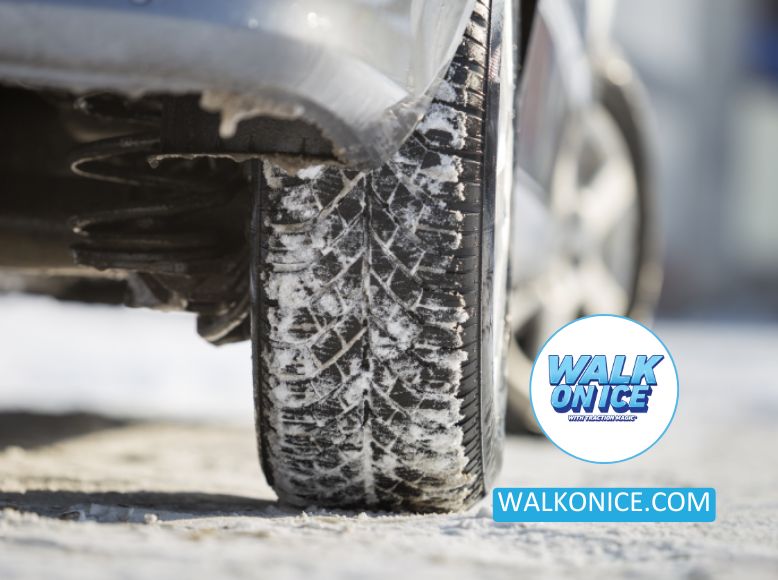How To Get Traction On Ice Driveway

Ice, snow, and freezing rain are the bane of motorists. While some people might think that it’s just a matter of slowing down and driving more carefully, in reality, navigating on icy roads requires a whole new approach.
What do you do for walking on ice and driving on slippery driveways? Here’s a quick guide on how to drive on icy roads:
Traction for walking on ice
To make sure you don’t fall and slip on slippery driveways, always keep a traction agent handy.
With its gripping and absorbent properties, Walk on Ice is made up of geo-crystals. ‘Absorbers’ soak up water while ‘grippers’ grip the snow to create a non-slip surface. Walk On Ice is safe for your pets and children, unlike salt-based products. It is non-corrosive and will not damage your concrete and asphalt. The all-natural components of this product do not burn your vegetation and keep your greenery healthy.
How to get traction on ice driveway while driving
Your car will lose traction, and you’ll have a hard time steering, which means driving at an appropriate speed will be crucial. If your car starts sliding, don’t panic and slam on the brakes—you won’t be able to stop as quickly this way and could end up going off the road or into another vehicle. Instead, gently apply pressure to the brake pedal until you’ve slowed down enough for your vehicle to regain traction. Watch a couple of how to drive on icy roads videos.
Get non-slippery boots
Non-slip boots are a great way to protect your feet from the cold, wet and rough terrain. They help you maintain good traction on icy roads. The best non-slip boots will have an upper made from durable materials like leather or synthetic materials that are designed to resist abrasion and provide protection against water infiltration into the boot.
Get ready for winter with Walk On Ice instant traction on snow and ice
Keep an emergency kit in the car.
If you’re in icy road conditions, ensure your car is prepared for the worst. Take a few minutes before leaving on a trip to make sure that you have the following items in your vehicle:
- Flashlight and batteries
- Blankets (several)
- First aid kit with gauze pads and bandages for cuts/scrapes
- Bottled water (1 gallon per person per day)
- Food like granola bars or fruit leather bars.
Don’t put on snow tires or chains till you have to
However, if you don’t have snow tires and there is a possibility of icy conditions, then it’s probably best to wait until you can put on chains before heading out. This goes doubly so if there are any other vehicles around (including trucks).
What To Do If Your Car Is Stuck In Snow
Even with all the right precautions, there’s always that frustrating scenario: you pull into your icy driveway, and the car just won’t budge. So, what to do if your car is stuck in snow? First, don’t floor the gas pedal—it usually just digs your tires in deeper. Instead, gently rock the vehicle back and forth by alternating between drive and reverse. If that doesn’t work, spreading traction material like sand, kitty litter, or a dedicated traction agent such as Walk On Ice around your tires can help the wheels grip and get you moving again. Keep a small bag of traction aid in your trunk during the winter months—it can be the difference between a quick fix and calling for a tow truck.
How Thick Should Ice Be To Drive On?
Driveways aren’t the only place traction matters. Many winter enthusiasts ask, how thick should ice be to drive on when venturing out onto frozen lakes. As a general rule, ice needs to be at least 12–15 inches thick to support a car or small truck safely. Anything less, and you’re risking a break-through that can be disastrous. Compare this to walking: ice only needs to be about 4 inches thick to support a person. This difference shows how much more stress vehicles put on icy surfaces. While most of us won’t be driving on lakes, knowing these numbers helps you appreciate just how cautious you need to be when dealing with ice, whether it’s natural or on your own property.
Kitty Litter For Ice Driveway: A Temporary Fix
One of the most common quick fixes people try is kitty litter for ice driveway traction. It feels clever—something cheap and gritty to keep you from slipping. But does it actually work? Sort of. Clay-based kitty litter can provide a little traction, but once it gets wet, it tends to clump, freeze, and turn into a mess that sticks to your boots and tires. It doesn’t melt ice and doesn’t provide reliable grip in extreme conditions. Sand has similar issues: while it gives temporary grit, it scatters quickly and can clog drains come spring. If you want something long-lasting and mess-free, a mineral-based traction agent like Walk On Ice is designed to stay effective without creating a bigger problem later.
How To Keep Driveway From Freezing
Instead of only reacting after the ice forms, why not think about prevention? A common question is how to keep driveway from freezing in the first place. Regular snow shoveling is one step—ice forms when packed snow melts during the day and refreezes at night. If you clear snow before it compacts, you can prevent much of that cycle. Another preventative trick is sealing your asphalt or concrete, which reduces the amount of moisture that seeps in and later freezes. For those who want a more high-tech solution, heated driveway systems (electric or hydronic) can stop ice from forming altogether, though they come with high installation and energy costs. For most homeowners, the practical balance is a mix of quick snow removal and keeping traction agents on hand for when conditions inevitably get slippery.
Conclusion: Be Prepared, Stay Confident
So, navigating winter isn’t just about knowing how to get traction on an icy driveway—it’s about being ready for all the curveballs ice and snow can throw at you. From learning what to do if your car is stuck in snow, to understanding how thick ice must be to drive on, to recognizing the limitations of kitty litter for ice driveway traction, every bit of knowledge helps. And if prevention is on your mind, figuring out how to keep driveway from freezing will save you plenty of frustration later.
Pair this awareness with practical tools like Walk On Ice for instant traction, and you’ve got a strategy that makes winter manageable instead of overwhelming. The cold months will always bring challenges, but with preparation and the right products, you can face them with confidence instead of caution. After all, safety in winter isn’t about avoiding the outdoors—it’s about making sure every step, and every drive, is secure.
FAQs
Other Ice Melt Products
Safe Paw
The Original and #1 Selling Pet and Child Safe Ice Melt for over 20 years. Guaranteed environmentally safe – will not harm waterways and sensitive wetlands. All products are made in the USA.

Safe Thaw
Imagine an ice melt you can put down and never worry about. It won’t harm pets, kids, and your property. That’s Safe Thaw. Unlike anything else on the market, Safe Thaw can change how winter affects our planet.



